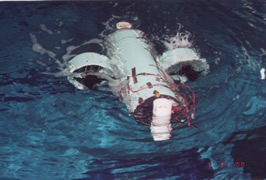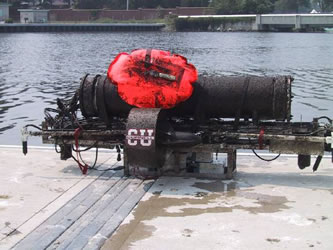
 |
||||||
![]()
![]()
In The Beginning...
 The
CUAUV team, as we know it today, was started by sophomores Serguei Vassilvitskii,
Nidhi Kalra, Jack Chuang, and Walter Chang in September of 1999, under the supervision
of Cornell Professor Kevin Kornegay of Electrical Engineering. Although many
original team members have graduated and been replaced by new faces, Professor
Kornegay continues to be our advisor/mentor/administrative liaison, providing
incredible support for the team. Originally known as the BRAIN team (for Big
Red Artificial Intelligence Navigator), CUAUV gives students the opportunity
to apply the knowledge learned in classroom studies in a systems engineering
project that demands much organization, innovation, and teamwork to be successful.
The
CUAUV team, as we know it today, was started by sophomores Serguei Vassilvitskii,
Nidhi Kalra, Jack Chuang, and Walter Chang in September of 1999, under the supervision
of Cornell Professor Kevin Kornegay of Electrical Engineering. Although many
original team members have graduated and been replaced by new faces, Professor
Kornegay continues to be our advisor/mentor/administrative liaison, providing
incredible support for the team. Originally known as the BRAIN team (for Big
Red Artificial Intelligence Navigator), CUAUV gives students the opportunity
to apply the knowledge learned in classroom studies in a systems engineering
project that demands much organization, innovation, and teamwork to be successful.
Redtide + Yellow Sub = The Gimbal Porpoise...
 In
1999-2000, forty students were members of the BRAIN team, but actually designed
and built two different AUVs, 'Redtide'
and 'Yellow Sub', to enter in the 3rd Annual AUV Competition . But, after the
final rules were released, which stated that only one entry per school was allowed
to enter, Team Redtide and Yellow Sub merged to create the 'Gimbal
Porpoise' as Cornell's AUV. The team and vehicle performed well at their
first competition at Disney's Coronado Springs Resort in Lake Buena Vista, FL,
taking first place in the Safety of Design, Technical Merit, and Craftsmanship
categories, and they tied for second place overall with the competition favorite
and two-time defending champion, MIT. More importantly, the competition experience
provided many lessons on how to improve the design and quality of the vehicle
for later years.
In
1999-2000, forty students were members of the BRAIN team, but actually designed
and built two different AUVs, 'Redtide'
and 'Yellow Sub', to enter in the 3rd Annual AUV Competition . But, after the
final rules were released, which stated that only one entry per school was allowed
to enter, Team Redtide and Yellow Sub merged to create the 'Gimbal
Porpoise' as Cornell's AUV. The team and vehicle performed well at their
first competition at Disney's Coronado Springs Resort in Lake Buena Vista, FL,
taking first place in the Safety of Design, Technical Merit, and Craftsmanship
categories, and they tied for second place overall with the competition favorite
and two-time defending champion, MIT. More importantly, the competition experience
provided many lessons on how to improve the design and quality of the vehicle
for later years.
Here is a copy of our 2000 Journal Paper for more technical details. (Adobe Acrobat Reader required).
Muddy water --> Sub Missing in Action...
 Competition
experienced and motivated to win, 22 students made up the 2001 BRAIN team. Knowledgeable
of the single-entry rule, they were able to focus all their efforts into building
a single submarine, thereby eliminating the last-minute combination of the previous
year. Although keeping with the removable hull, frame-based vehicle, which allowed
for easy transportation and mounting of sensors and peripherals, the team created
an entirely new AUV. The competition, at the U.S. Naval Academy in Annapolis,
MD, was going well until the finals. The Cornell AUV, was placed a strong 2nd
after the morning qualifier run, and was running its 20 minute mission flawlessly,
surfacing for 2 minutes after three 3 minute sweeps around the target area.
Two commands were intended to bring the vehicle back to the surface at the mission's
end: a 10 second, full-up thrust command from the high-level control at 19 minutes,
followed 2 minutes later by a 20 second, full thrust up command from a lower-level
process. The thrusters performed their job (divers could hear them), but the
vehicle never surfaced. Visibility in the competition arena was estimated to
be between 9 and 18 inches. Both competition and local Navy divers searched
for the sub, but were unsuccessful in finding it. Despite missing the data from
this final run, BRAIN placed 5th in the competition. A month later, Nauticos,
an expert in underwater object recovery, used side-scan sonar and located the
vehicle, still intact and sealed, in under an hour. After examining the data
recorded on the hard drive, the team found that the coveted ping rate and box
height information had indeed been logged by the AUV, which would have greatly
increased the team's standing.
Competition
experienced and motivated to win, 22 students made up the 2001 BRAIN team. Knowledgeable
of the single-entry rule, they were able to focus all their efforts into building
a single submarine, thereby eliminating the last-minute combination of the previous
year. Although keeping with the removable hull, frame-based vehicle, which allowed
for easy transportation and mounting of sensors and peripherals, the team created
an entirely new AUV. The competition, at the U.S. Naval Academy in Annapolis,
MD, was going well until the finals. The Cornell AUV, was placed a strong 2nd
after the morning qualifier run, and was running its 20 minute mission flawlessly,
surfacing for 2 minutes after three 3 minute sweeps around the target area.
Two commands were intended to bring the vehicle back to the surface at the mission's
end: a 10 second, full-up thrust command from the high-level control at 19 minutes,
followed 2 minutes later by a 20 second, full thrust up command from a lower-level
process. The thrusters performed their job (divers could hear them), but the
vehicle never surfaced. Visibility in the competition arena was estimated to
be between 9 and 18 inches. Both competition and local Navy divers searched
for the sub, but were unsuccessful in finding it. Despite missing the data from
this final run, BRAIN placed 5th in the competition. A month later, Nauticos,
an expert in underwater object recovery, used side-scan sonar and located the
vehicle, still intact and sealed, in under an hour. After examining the data
recorded on the hard drive, the team found that the coveted ping rate and box
height information had indeed been logged by the AUV, which would have greatly
increased the team's standing.
Here is a copy of our 2001 Journal Paper for more technical details. (Adobe Acrobat Reader required).
2002: Autonomy reigns

With the clear waters of Transdec, this competition was the first one to truly demand on-board vision. The goal was to search for boxes at the bottom of this man made pond. Each box had a random height as well as a unique barcode at the top which identified each one. A team would have to report both the distance from the top of the box to the surface as well as the barcode of the box. With a strategy to reaching the center of the pond and searching for targets, Cornell was the first team to ever show such advanced level of autonomy. The CUAUV team performed outstandingly and was the team which reported the most accurate data as well as most number of targets. Despite our brilliant performance, the team placed a close 2nd place.
Here is a copy of our 2002 Journal Paper for more technical details. (Adobe Acrobat Reader required).
![]()